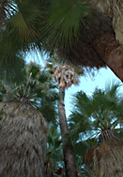The PDF of this section of the report is available here:
Ecology of the California Desert (PDF)

Fan Palm Oases
Fan palm oases occur along fault lines where hard rock forces water from underground to the surface. The desert fan palm is a native to the low hot deserts of California and can live for 80 or 90 years and grow up to 75 feet tall.
Ecology of the CA Desert
There are several ecologically important habitats and species found throughout the California desert. Severe aridity, extreme temperatures, intense sunlight, and high winds create a harsh environment for life in the California desert. Biological diversity can persist due, in part, to complex and interconnected ecological processes that sustain these ecosystems. Climate drives regional and local weather patterns, determines seasonal temperatures, frequency and size of precipitation events, and wind patterns. These processes in turn drive plant productivity and nutrient cycling. Geomorphology and desert landforms (e.g., mountains, alluvial fans, ephemeral streams, sand dunes) directly affect water infiltration, run-off, erosion, storage, and salt accumulation, as well as soils and nutrients.1 Wind, water, and biota interact with soil through processes of erosion, deposition, bioturbation, and compaction, making it more or less suitable for desert life.2 Wind patterns, wind erosion, rainfall, water erosion, and water distribution are critical processes that shape the structure and dynamics of desert ecosystems. The sum of these processes determine if, where, and what biodiversity can persist.
1 W.G. Whitford, Ecology of Desert Systems, (New York: Elsevier Science Ltd., 2002).
2 W.G. Whitford, Ecology of Desert Systems, (New York: Elsevier Science Ltd., 2002).
